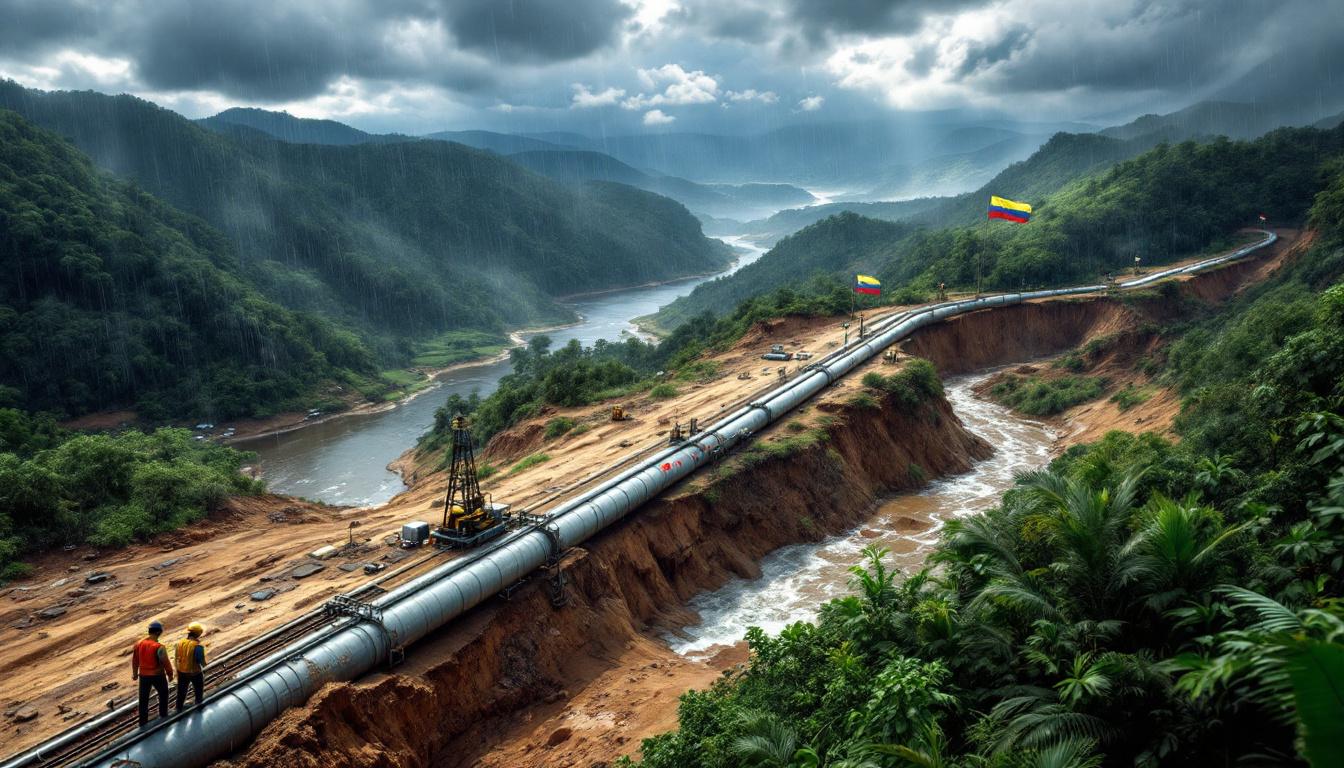Mounting Challenges: The Critical Crossroads for Mount Isa's Copper Smelter
The Mount Isa copper smelter stands at a critical juncture as federal and Queensland governments engage in high-level discussions to secure its future. This cornerstone of Queensland's resources sector faces potential closure, threatening thousands of jobs and risking significant disruption to Australia's copper supply chain. With stakeholders scrambling for solutions, the fate of this strategically important industrial asset hangs in the balance.
Recent talks between government ministers and Glencore leadership highlight the urgency of finding a sustainable path forward for an operation that underpins not just regional employment but Australia's sovereign manufacturing capabilities.
Why Mount Isa's Copper Smelter Matters to Australia
Economic Significance for Queensland
The Mount Isa copper smelter represents far more than just another industrial facility—it forms the backbone of northwestern Queensland's economy and supports extensive supply chain networks across the state. According to industry experts, the operation directly and indirectly supports thousands of jobs throughout the region, creating an economic multiplier effect that extends well beyond the smelter gates.
"The Mount Isa copper smelter is a cornerstone of Queensland's economy and supports the viability of nationally significant supply chain infrastructure like the Mount Isa to Townsville rail line and the Port of Townsville," said Queensland Resources Minister Dale Last following high-level discussions with Glencore executives.
This economic impact extends through multiple dimensions:
- Regional employment hub: The smelter creates stable, high-paying jobs in a region where such opportunities are limited
- Supply chain enabler: Local businesses from maintenance contractors to transport providers depend on the smelter's operations
- Infrastructure viability: The Mount Isa to Townsville rail corridor—a critical freight artery spanning approximately 1,000 kilometers—relies heavily on mineral transport volumes
- Port operations: The Port of Townsville's throughput and operational viability is significantly bolstered by copper exports
Regional economists estimate that each direct job at the smelter supports between 3-5 additional jobs in the broader community through indirect and induced economic effects, creating a substantial employment multiplier that ripples through local economies.
Strategic Importance to National Interests
Beyond regional economic impacts, the Mount Isa copper smelter holds strategic significance for Australia's industrial sovereignty and resource processing capabilities. As global competition for critical minerals intensifies, maintaining domestic processing infrastructure has become increasingly vital.
Federal Industry Minister Tim Ayres emphasized this point, noting that the smelter represents "a vital industrial site for the Mount Isa community and the broader region" while warning that closure would have "a detrimental impact on Australia's sovereign capability and other facilities downstream that rely on the smelter."
The smelter's strategic importance is multifaceted:
- Value chain integration: The facility allows Australia to process copper concentrate domestically rather than shipping raw materials offshore
- Technical capability retention: Maintains specialized metallurgical skills and knowledge within Australia's workforce
- Supply chain security: Reduces dependence on overseas processing during times of global market volatility
- Critical minerals strategy alignment: Supports Australia's positioning as not just an extractor but a processor of minerals essential to the energy transition
Metallurgical experts note that once processing capabilities are lost, rebuilding them becomes extraordinarily difficult and expensive—making the preservation of existing assets like the Mount Isa smelter even more crucial to Australia's industrial strategy.
What's Happening with Government Intervention?
Recent High-Level Discussions
In a significant development, Federal Industry Minister Tim Ayres and Queensland Resources Minister Dale Last met with Glencore's senior leadership on June 19, 2025. This high-level engagement signals the seriousness with which both governments view the smelter's situation.
According to ministerial statements, the discussions were characterized as "frank and focused," with both levels of government presenting a united front in addressing the challenges facing the operation. This rare alignment between state and federal authorities highlights the national significance of the issue.
Key developments from the recent discussions include:
- Establishment of a joint government working group to explore viable pathways forward
- Agreement on regular ministerial updates regarding progress
- Commitment to transparent engagement with the Mount Isa community
- Plans for follow-up site visits and community consultations
The talks represent the culmination of months of behind-the-scenes engagement by government officials at multiple levels, now elevated to ministerial involvement due to the increasing urgency of finding a resolution.
Queensland Government's Position
The Queensland Government has adopted a proactive stance in addressing the smelter's challenges, recognizing its outsized importance to the state's resources sector and regional communities. Resources Minister Dale Last has taken a leading role in negotiations, emphasizing both the facility's economic importance and the government's commitment to finding solutions.
"The Queensland Government is engaging genuinely to deliver a solution that satisfies all stakeholders, and we expect genuine engagement from Glencore in return," Last stated following the ministerial meeting. This balanced approach signals the government's willingness to work collaboratively while also placing clear expectations on the facility's operator.
Queensland's position encompasses several key elements:
- Economic impact focus: Highlighting the thousands of jobs and regional prosperity at stake
- Infrastructure concerns: Emphasizing interdependencies with rail and port operations
- Community engagement: Committing to visit the region and meet directly with affected stakeholders
- Collaborative approach: Working in tandem with federal counterparts rather than pursuing independent solutions
State officials have indicated they are examining various support mechanisms that could address the smelter's viability challenges while ensuring taxpayer value and environmental responsibility.
Federal Government's Involvement
The federal government's engagement in the Mount Isa situation reflects the national strategic significance of the facility. Industry Minister Tim Ayres has characterized the federal role as "closely monitoring" while actively working with Queensland authorities to secure a positive outcome.
"The Federal Government is committed to working with the Queensland Government to secure the best outcome for the Mount Isa community and Australia's critical minerals processing capabilities," Ayres noted following the ministerial discussions.
Federal involvement centers around several key considerations:
- Sovereign capability concerns: Preserving domestic processing capacity for critical minerals
- National supply chain resilience: Maintaining integrated minerals processing networks
- Regional development implications: Supporting economic sustainability in remote communities
- Critical minerals strategy alignment: Ensuring Australia maximizes value from its mineral resources
Industry analysts note that federal engagement signals potential access to national funding mechanisms and policy levers that extend beyond state capabilities, potentially expanding the range of solutions available to address the smelter's challenges.
What Challenges Does the Smelter Face?
Operational Viability Concerns
While specific operational details remain confidential, industry experts point to multiple factors likely challenging the Mount Isa smelter's viability. Global copper smelting faces intensifying pressures from newer, more efficient facilities in developing nations, combined with rising energy costs and increasingly stringent environmental standards.
Metallurgical engineering sources familiar with Australian smelting operations identify several probable challenges:
- Energy intensity: Copper smelting requires significant electricity and natural gas inputs, making operations vulnerable to Australia's rising energy costs
- Infrastructure age: Many Australian processing facilities face challenges maintaining competitive efficiency with equipment installed decades ago
- Environmental compliance: Modern emissions standards require substantial capital investment in pollution control technologies
- Technical complexity: Maintaining specialized skills and knowledge becomes increasingly difficult as the domestic processing sector contracts
- Global competition: Newer overseas facilities often benefit from lower labor costs, less stringent regulations, and government subsidies
These operational challenges create a difficult economic equation for aging facilities like Mount Isa, requiring creative solutions that balance commercial viability with strategic importance.
Community Impact Considerations
Beyond operational metrics, the human impact of potential closure looms large in discussions about the smelter's future. The facility's significance to Mount Isa extends far beyond direct employment, touching virtually every aspect of the community's social and economic fabric.
Community leaders highlight several dimensions of potential impact:
- Employment cascade: Job losses would extend well beyond direct employees to contractors, suppliers, and service providers
- Population stability: Significant employment reductions could trigger outmigration, destabilizing housing markets and reducing local business viability
- Service viability: Schools, healthcare facilities, and other essential services depend on maintaining sufficient population
- Social cohesion: Large-scale economic disruption often correlates with increased social challenges including mental health issues
- Regional identity: The smelter represents not just jobs but a proud industrial heritage deeply woven into the community's identity
Economic development experts note that remote resource communities like Mount Isa face particular challenges weathering major industrial transitions, with fewer alternative employment pathways compared to metropolitan areas, making government intervention particularly critical.
How Would Closure Impact Australia's Resources Sector?
Supply Chain Disruptions
The Mount Isa copper smelter occupies a pivotal position in Australia's minerals processing infrastructure, with ripple effects extending throughout multiple supply chains. Its potential closure would create disruptions extending far beyond the immediate facility.
Resources sector analysts identify several critical supply chain vulnerabilities:
- Downstream processing: Facilities that rely on the smelter's output would face input constraints or increased costs sourcing materials from alternative suppliers
- Rail network utilization: The Mount Isa to Townsville rail corridor could face significant volume reductions, potentially undermining its commercial viability
- Port operations: The Port of Townsville would lose a major export commodity, potentially affecting scheduling efficiency and overall throughput
- Logistics providers: Transportation and logistics companies specialized in handling copper products would face business disruption
- Support industries: Maintenance contractors, equipment suppliers, and technical service providers would lose significant business activity
Industry experts note that supply chain disruptions often create cascading effects that exceed initial estimates, as interdependencies throughout complex industrial networks amplify localized impacts.
Strategic Mineral Processing Concerns
From a national strategic perspective, the potential loss of the Mount Isa smelter raises significant concerns about Australia's minerals processing capabilities and sovereign industrial capacity. As global competition for critical minerals intensifies, maintaining domestic processing infrastructure becomes increasingly valuable.
Metals industry strategists highlight several long-term strategic implications:
- Value chain positioning: Reduced domestic processing capacity may shift Australia further toward being primarily a raw materials exporter rather than a value-adding processor
- Technical capability erosion: Specialized metallurgical knowledge and skills could be permanently lost if the workforce disperses
- Investment signaling: Closure might discourage future investment in Australian minerals processing infrastructure
- Global competitiveness: Australia's position in the global critical minerals market could be weakened if processing capabilities diminish
- Energy transition implications: Domestic copper processing capability aligns with Australia's emerging position in clean energy supply chains
National security experts additionally note that critical minerals processing capacity represents a strategic asset in an era of increasing resource nationalism and supply chain vulnerability, giving the Mount Isa situation implications beyond purely commercial considerations.
What's Next for Mount Isa?
Ongoing Stakeholder Engagement
Following the ministerial-level discussions, both federal and state governments have committed to expanding engagement with all stakeholders affected by the smelter's situation. This multi-level approach aims to ensure that any solution addresses the diverse needs of the community, workforce, and industry.
Planned engagement activities include:
- Ministerial visits to the Mount Isa region in coming weeks
- Direct discussions with community representatives and local government
- Facility tours to better understand operational challenges
- Regular briefings for affected stakeholders on negotiation progress
- Establishment of community consultation mechanisms to gather local input
"We are continuing to engage in good faith with Glencore and will be visiting the region soon to tour the facilities and meet with community representatives," Minister Last confirmed, underscoring the hands-on approach being taken by government officials.
Potential Pathways Forward
While specific solutions remain under negotiation, industry experts suggest several potential pathways that could secure the smelter's future. These approaches would likely combine elements of operational improvement, government support, and strategic repositioning.
Possible elements of a comprehensive solution might include:
- Energy cost mitigation: Special electricity pricing arrangements or renewable energy partnerships to address a key input cost
- Capital investment support: Government co-investment in modernization or environmental compliance upgrades
- Infrastructure integration: Enhanced coordination with rail and port operations to optimize the full supply chain
- Technical innovation: Implementation of more efficient processing technologies to improve competitive position
- Strategic partnerships: Exploration of joint ventures or cooperative arrangements with downstream processors
Metallurgical industry consultants note that successful smelter revitalization efforts internationally have typically required creative public-private partnerships that distribute both risks and benefits among multiple stakeholders rather than placing the full burden on either industry or government alone.
Frequently Asked Questions: Mount Isa Copper Smelter Situation
How many jobs are connected to the Mount Isa copper smelter?
The smelter underpins thousands of jobs both directly at the facility and indirectly through the supply chain and supporting industries across the Mount Isa region and along transportation corridors to Townsville. While exact figures remain confidential, industry multiplier effects suggest each direct smelting job supports between 3-5 additional positions throughout the regional economy.
Why are governments hold talks to secure mount isa's future?
The strategic importance of the smelter to Australia's sovereign capabilities, regional employment, and critical infrastructure makes it a matter of state and national interest, prompting government engagement. Additionally, the potential social and economic impacts of closure would create significant public policy challenges requiring coordinated response from multiple levels of government.
What infrastructure depends on the Mount Isa smelter's continued operation?
Key infrastructure includes the Mount Isa to Townsville rail line and the Port of Townsville, both of which rely significantly on the materials flow from the smelter operations. The rail corridor in particular derives substantial revenue from copper transport, with potential viability concerns if this volume were to disappear.
What is Glencore's position on the smelter's future?
While specific details of Glencore's position weren't disclosed in the government statements, both ministers indicated they expect "genuine engagement" from the company in finding a constructive solution. Industry analysts suggest the company likely faces challenging economics but recognizes the facility's strategic importance and community impact.
When will a decision about the smelter's future be made?
No specific timeline has been announced, but the high-level nature of the discussions and planned regional visits suggest the matter is being treated with urgency by all parties involved. Based on similar industrial negotiations, experts anticipate that a framework agreement outlining a path forward might emerge within 3-6 months, with implementation details to follow.
The future of this vital facility will likely depend on finding a balance between economic realities and strategic priorities, with recent copper price predictions and global copper supply forecast playing a crucial role in determining viable solutions. Furthermore, innovative copper investment strategies may offer pathways to sustainability in light of rising copper demand driven by electrification trends.
According to the Mount Isa Future Ready Economy Roadmap, the city is already preparing for economic transformation, with potential shifts in mining industry trends shaping longer-term planning beyond the immediate smelter situation.
Disclaimer: This article presents analysis and information based on publicly available statements from government officials and industry sources. The situation remains fluid, and outcomes depend on ongoing negotiations between multiple stakeholders. Economic projections and potential solutions represent informed analysis rather than confirmed developments.
Searching for the Next Big Australian Mining Discovery?
Don't miss out on potential market-moving ASX mineral announcements – Discovery Alert's proprietary Discovery IQ model delivers instant notifications when significant discoveries are announced, giving you a crucial edge in the market. Explore historic returns from major discoveries and start your 30-day free trial today at Discovery Alert's discoveries page.




